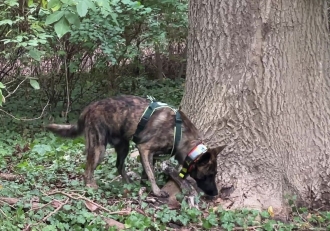Tracking stem necrosis in ash dieback with trained dogs

Due to comparatively rapidly progressing decay processes of the roots, trees affected by ash dieback may fall and cause damage. This can be observed especially in combination with the occurrence of stem base necrosis. During visual tree inspection, this impact on public safety can only be detected when aboveground damage features such as bark lesions are visible. This damage, which is sometimes inconspicuous, is regularly obscured by foliage, undergrowth, or vegetation. In such cases, the assessment of is time-consuming and cost-intensive. This effort can be reduced to a reasonable level by pre-selection of affected ash trees by woody pathogen tracking dogs.
Through several years of training, woody pathogen tracking dogs can differentiate odor patterns. They can indicate the special smell of the decaying processes of bark and roots of diseased ash trees by learned behavior. In cooperation with the expert D. Schneider-Blank, the use of trained dogs to facilitate road safety inspections of ash trees is currently being tested in several studies.
During initial search missions, the dogs indicated all trees where bark necrosis was also visually detected by the inspector. Further investigations are planned.
For this purpose, we advise on the possibility of using tracking dogs, drawing on our many years of experience. In addition, we carry out search missions with certified woody pathogen tracking dogs as well as the associated examinations for the assessment of public safety and prepare expert reports on the basis of the results.

